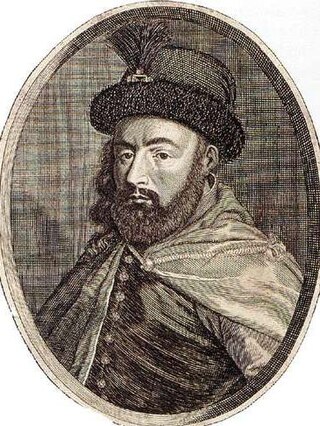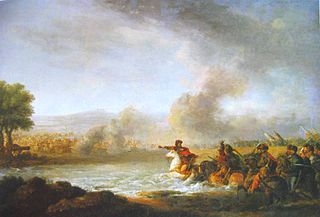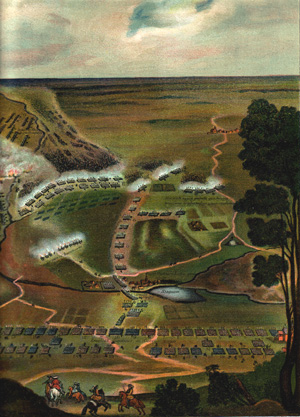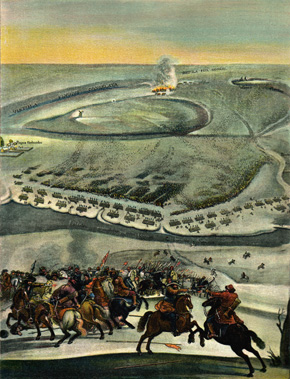
Charles X Gustav, also Carl Gustav, was King of Sweden from 1654 until his death. He was the son of John Casimir, Count Palatine of Zweibrücken-Kleeburg and Catherine of Sweden. After his father's death he also succeeded him as Pfalzgraf. He was married to Hedwig Eleonora of Holstein-Gottorp, who bore his son and successor, Charles XI. Charles X Gustav was the second Wittelsbach king of Sweden after the childless king Christopher of Bavaria (1441–1448) and he was the first king of the Swedish Caroline era, which had its peak during the end of the reign of his son, Charles XI. He led Sweden during the Second Northern War, enlarging the Swedish Empire. By his predecessor Christina, he was considered de facto Duke of Eyland (Öland), before ascending to the Swedish throne. From 1655 to 1657, he was also Grand Duke of Lithuania.

The Deluge was a series of mid-17th-century military campaigns in the Polish–Lithuanian Commonwealth. In a wider sense, it applies to the period between the Khmelnytsky Uprising of 1648 and the Truce of Andrusovo in 1667, comprising the Polish theatres of the Russo-Polish and Second Northern Wars. In a stricter sense, the term refers to the Swedish invasion and occupation of the Commonwealth as a theatre of the Second Northern War (1655–1660) only; in Poland and Lithuania this period is called the Swedish Deluge, or less commonly the Russo–Swedish Deluge due to the simultaneous Russo-Polish War. The term "deluge" was popularized by Henryk Sienkiewicz in his novel The Deluge (1886).

The Second Northern War (1655–60), was fought between Sweden and its adversaries the Polish–Lithuanian Commonwealth (1655–60), the Tsardom of Russia (1656–58), Brandenburg-Prussia (1657–60), the Habsburg monarchy (1657–60) and Denmark–Norway. The Dutch Republic waged an informal trade war against Sweden and seized the colony of New Sweden in 1655, but was not a recognized part of the Polish–Danish alliance.

The Battle of Warsaw took place near Warsaw on July 28–July 30 [O.S. July 18–20] 1656, between the armies of the Polish–Lithuanian Commonwealth and Sweden and Brandenburg. It was a major battle in the Second Northern War between Poland and Sweden in the period 1655–1660, also known as The Deluge. According to Hajo Holborn, it marked "the beginning of Prussian military history".

George II Rákóczi, was a Hungarian nobleman, Prince of Transylvania (1648-1660), the eldest son of George I and Zsuzsanna Lorántffy.

The Treaty of Königsberg was concluded on 7 January (O.S.) / 17 January (N.S.) 1656 during the Second Northern War. Frederick William I, the "Great Elector" of Brandenburg and duke of Prussia, was forced to join the Swedish camp and became a Swedish vassal for the Duchy of Prussia and Ermland. In a second treaty, negotiated on 24 February 1656 in Königsberg (Królewiec), Frederick William I concluded a defensive alliance with France.

The Battle of Warka occurred on April 7, 1656 between the forces of the Polish–Lithuanian Commonwealth, commanded by Stefan Czarniecki, and the forces of the Swedish Empire, commanded by Frederick VI, Margrave of Baden-Durlach. Lasting about two hours, the battle ended in a Polish victory.

The Battle of Kłecko was fought on May 7, 1656, between forces of the Polish–Lithuanian Commonwealth commanded by Regimentarz Stefan Czarniecki and Jerzy Sebastian Lubomirski and a Swedish force commanded by prince Adolf Johan av Pfalz-Zweibrücken. The Polish–Lithuanian force was more than 12,000 strong and consisted mostly of cavalry, while the Swedes numbered around 7,000 artillery, infantry and cavalry. The Swedes achieved a tactical victory in that they escaped destruction by the Poles, who were unable to get to the Swedish army entrenched behind the Welnianka River, and various ditches and swamps. Swedish army lost 428 dead, while the Polish army sustained 70 dead and wounded, 2,000 dead or 3,000 dead, including 40 companions dead.

The Battle of Gołąb was fought on either 18 or 19 February 1656, between forces of the Polish–Lithuanian Commonwealth commanded by Stefan Czarniecki on one side, and on the other Swedish Empire's army commanded by Charles X Gustav. This battle was essentially a meeting engagement with Swedish troops arriving on the battlefield at different times. It is uncertain how many actually participated, and its actual date is disputed. Some sources, such as Polish-language Military Encyclopedia, claim it took place on 18 February, while historian Leszek Podhorecki wrote that it was on 19 February. The outcome was a Swedish victory.
The Battle of Sobota was a battle that took place near Sobota, Poland, on 23 August 1655, between the armies of the Polish–Lithuanian Commonwealth on the one hand and of Sweden on the other.

The Battle of Chojnice was a surprise nighttime attack followed by a run-and-chase battle during The Deluge.

The relations between Denmark and Sweden span a long history of interaction. The inhabitants of each speak related North Germanic languages, which have a degree of mutual intelligibility. Both countries formed part of the Kalmar Union between 1397 and 1523, but there exists an inherited cultural competition between Sweden and Denmark. From 1448 to 1790 the two kingdoms went to war against each other at nearly every opportunity; in more than one case a new king tried to prove his worth by waging war on the other country for little or no political reason. Eleven Dano-Swedish wars took place between 1521 and 1814.
The Lwów Oath was an oath made on April 1, 1656 by Polish king John II Casimir in Latin cathedral in the city of Lwów.
The Battle of Jarosław took place during the Deluge on March 15, 1656. Polish-Lithuanian Commonwealth forces under the command of Stefan Czarniecki defeated the Swedish forces commanded by Charles X Gustav of Sweden.
The Battle of Tykocin took place on 13 July 1656 and was one of battle of the Swedish invasion of Poland. It resulted in a victory of Sweden and Brandenburg forces, commanded by Duke Boguslaw Radziwill, and ended siege of Tykocin.
The Battle of Kcynia took place on June 1, 1656, and was one of battles of the Swedish invasion of Poland. It resulted in a victory of Swedish forces, commanded by King Charles X Gustav and Adolph John I, Count Palatine of Kleeburg.

The Battle of Magierów took place on 11 July 1657, during the period in Polish history known as the Swedish Deluge. Polish army commanded by Stefan Czarniecki, and supported by Crimean Tatars, defeated a Transilvanian-Cossack-Moldavian-Wallachian army of George II Rákóczi.
The Battle of Czarny Ostrów took place on July 20, 1657, during the period in Polish history known as the Deluge. The Polish Crown army commanded by Hetmans Stefan Czarniecki, Jerzy Lubomirski and Stanisław Potocki, supported by Crimean Tatars, defeated a Transylvanian-Cossack-Moldavian-Wallachian army under George II Rakoczi.

Events from the year 1656 in Sweden

The Battle of Sandomierz was a series of battles during Deluge.












